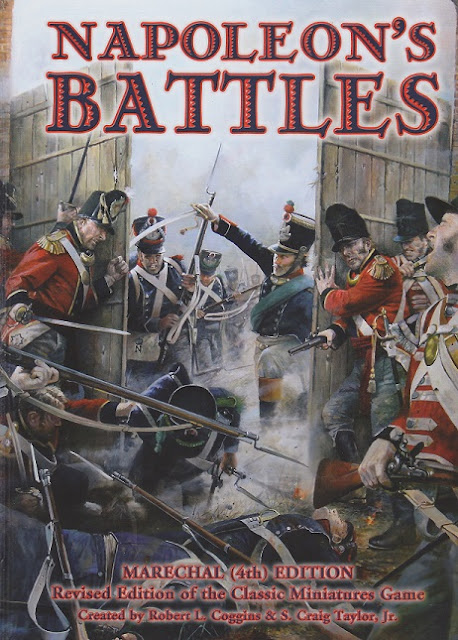Napoleon's Battles was originally published by the venerable Avalon Hill Game Company in 1989. The game portrays Napoleonic warfare at the grand-tactical level, with the smallest manoeuvre unit being the infantry or cavalry brigade, and horse or heavy foot artillery batteries.
Since the demise of Avalon Hill, the game has been reprinted three times, and the most recent version is Napoleon's Battles Marechal Edition, also known as NBIV. This latest version is still basically the same set of rules, but with several small changes that improve gameplay, realism and the historical accuracy of scenario orders of battle. In addition, some rules that were standard are now optional.
Ground scale: 1" = 100 yards
Figure scale: 1 infantry figure = 120 bayonets, 1 cavalry figure = 80 sabres, 1 gun figure = 1 heavy or horse artillery battery.
Time scale: 1 full turn = 30 minutes of real time
Why Napoleon's Battles?
Here are a few of what for me are Napoleon's Battles' "killer features"...
Design-for-effect
Napoleon's Battles doesn't get bogged down in modelling the specifics of what are happening in each brigade. The player decides whether their formation is optimised for road travel, movement, combat or cavalry defence, and the invisible internal brigade commander takes care of the rest. The dice will decide how well he does.Command and control is modeled by means of command spans for each general. There are no orders to write or interpret. For cases where a general is out of command of his superior, the player rolls against the general's response number, a reflection of his capacity for independent initiative, to see what he can do.
Flavour
Napoleon's Battles contains a lot of period "flavour". Some examples...There is an optional All-Out attack phase in which a player may employ only his guard units, reflecting the tendency for the rest of the battlefield to seem to pause when the elites went in, as everyone else awaited the outcome, or so the original designers claimed. I'm not so sure how historical this is, but it does add to the player's immersion.
Cavalry do not automatically remain under control after a successful charge. They might...but they might also go charging off somewhere else and possible lose their cohesion in the process. The worst offenders in this regard are British (but not KGL) cavalry.
Armies' supply wagons can be modeled, and also be captured by the enemy, with the enemy risking losing control of the capturing unit while the men take advantage of the opportunity to plunder.
Some of the better-known generals have optional rules that bring some of their particular personalities to the game. When Napoleon is in command after 1807, the French forces have greater staying power; Wellington can save his move until later in the turn until it's clearer where he will be needed; Blucher can attach himself to a unit to improve its performance with out affecting the army;s command and control (Gneisenau is looking after that), and the Russians perform better in column when Suvorov is running things.
Generals' "Personalities"
Even for the vast majority of generals with no special rules to their names, each is given ratings in four different attributes: command range, inspirational ability, command initiative and tactical ability. In addition, generals are rated for how much their command initiative drops when commanding at higher than divisional level. In other words, some generals that show high initiative commanding a division are less sure of themselves when commanding a corps.
Detailed unit stats
The game provides games stats for the major and minor armies that affect movement, firing, close combat and morale. The stats also change in line with the changes and evolution of the armies throughout the period e.g. the French, who stats aren't anything special between 1792 and 1800 (including stats for Ancien Regime units and massed poorly-trained sans-culottes), then things improve between 1805 and 1807, not quite so good between 1808 and 1812, then a serious dip in quality for 1813 and 1814, before we seem some improvement in 1815. In a similar way, the stats for Austria, Prussia and Russia reflect the evolution of their tactics following their big defeats between 1805 and 1807. Commanding a miniature Prussian 1813 army feels very different to commanding a Prussian 1806 army.
Such detail in unit attributes (and those of generals) ,might sound like a recipe for a slow, complicated game, but the rich depth of stats is married to rules that are straightforward and elegant, making Napoleon's Battles surprisingly quick to play.
Scale
Napoleon's Battles puts the player in the role of corps or army commander, manoeuvring brigades, not battalions. This, combined with the historically-rich yet easy to use rules brings the even the biggest Napoleonic Battles within reach of the player.
 |
| The Original Avalon Hill game box |

No comments:
Post a Comment